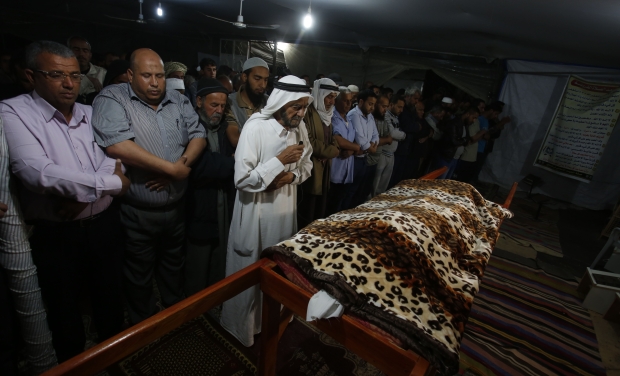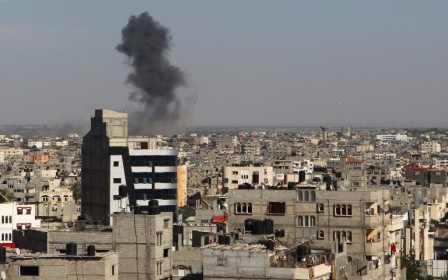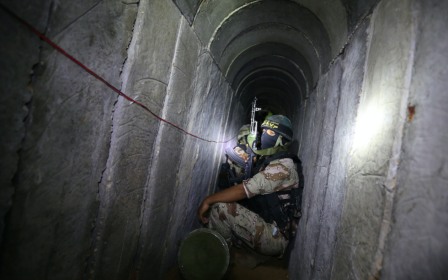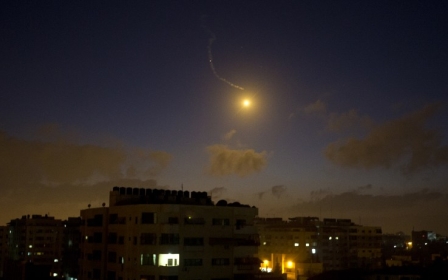For Gazans, Israeli shelling harkens back to 2014 war
AL-FOUKHARI, Gaza - In the al-Foukhari neighbourhood, several residents feared a new Israeli offensive in Gaza as they came together to bury Zaina Attia al-Amour, a 54-year-old woman who was killed by an Israeli strike.
At al-Reda mosque, relatives and friends gathered for a ceremony before the burial.
Her son Mohammed al-Amour, who was released two months ago after a several-year stint in Israeli prisons, stood next to his mum’s body and kissed her forehead.
“My mum was killed while sitting peacefully in our farm,” he said as his sister cried and two of Amour’s small grandchildren tried to wake up their grandmother.
Several Israeli artillery shells hit the area where Amour lived along Gaza’s border with Israel. Residents are concerned that such tensions could be the start of a new war.
“We are used to this practice of wars every two years,” said 41-year-old Abu Kareem, who attended the funeral. “But where else do we go? Nowhere is safe."
Al-Foukhari was one of the worst-hit areas during the 2014 Israeli offensive on Gaza, with many people killed and some trapped underneath the rubble of their homes until rescue teams were able to dig them out days later.
Abu Kareem says that during the 2014 offensive, he had to leave his house and farm. After 51 days he came back to find his home partially destroyed, and every animal of his had died due to artillery shelling and a lack of water.
Israeli warplanes bombed at least five positions around Gaza's defunct international airport near the southern city of Rafah and in the nearby farming areas on Wednesday. As a result, several of the Bedouin families fled the area to stay with relatives in central Rafah.
“How do I explain this displacement to my children? They wet their beds at night, they can’t leave me or their mom - but I am an adult and I don’t feel safe either. How can we as parents tell them they are safe?” Abu Kareem said.
His youngest son screams each time he hears a door slam, he added.
But people in al-Foukhari are worried about what could happen next. Israeli media has said the operation is aimed at discovering tunnels. One tunnel has been found so far.
A military spokesman, Peter Lerner, told Israeli media that it was too early to say whether the tunnel – found to be 29 metres deep – was old or one that had been partially destroyed during the previous war and reconstructed.
However, Hamas issued a press release saying that the discovered tunnel was an old one and was used in previous operations during the 2014 offensive.
Following Amour's killing, Hamas' military wing, the al-Qassam Brigades, announced in a statement warning they would fight back.
“We will not allow a continuation of Zionist aggression against the Gaza Strip. The enemy should not invoke any reason whatsoever for its actions and leave the Gaza Strip immediately.”
Yet Gaza’s residents continue to live in a war-like atmosphere.
“We did not yet wake up from the trauma of the previous war,” said Ibrahim Abu Mouamar, head of the National Association for Democracy and Law.
Hamas MP Khalil al-Hayya said Israel was responsible for the ongoing tension, but there were some efforts being made from abroad to calm the situation.
“We have been in touch with Qatar, Egypt and the United Nations to contain the situation,” he posted on his Facebook page.
On Wednesday, Israeli tanks stationed along the Gaza border shelled several areas in Gaza’s eastern Shujaiyya district, targeting Hamas military camps.
On Thursday, Israel's army said it launched air strikes on four Hamas targets in the Gaza Strip in response to mortar rounds fired at Israel.
Hamas said the mortars were in response to artillery shelling. However, accusations between both sides do not seem to matter for Palestinians in Gaza. Tensions remain high at the border.
“If this continues, we will have to go to UN schools to seek shelter,” said Abu Kareem.
Final exams take place at this time of year, but if Israel's military continues to fire into Gaza, it remains unclear whether schools can remain open.
Human rights groups continued to express concern about the crisis. According to Rami Abdu, chairman of Euor-Mid Monitor for Human Rights, over the past 48 hours 29 artillery shells and 11 air strikes have hit the strip.
Gaza’s health ministry said that in addition to Amour's death, five civilians had been injured, including three children.
Meanwhile, Abdu says that Palestinian factions had also fired 23 mortars.
“We call on our partner organisations and the United Nations to immediately intervene to end the tension on Gaza’s eastern border.”
But that still does not bring any comfort to the residents of al-Foukahri, Rafah and Shujaiyya.
“Are we going to wait for bulldozers driving into our bedrooms?” asked Abu Kareem. "I know a new offensive could start soon."
Israeli spokesman Lerner said there was no intention for a new offensive.
The past 48 hours have been seen among Gazans as the worst violence since 2014. Gaza has been devastated by three offensives since 2008, and reconstruction has been painstakingly slow amid an Israeli blockade on imports.
"Enough of this tragedy - let our children continue to live in peace and not know only death,” Abu Mouamar told MEE, adding that personally he was no longer able to convince his child that he is safe.
New MEE newsletter: Jerusalem Dispatch
Sign up to get the latest insights and analysis on Israel-Palestine, alongside Turkey Unpacked and other MEE newsletters
Middle East Eye delivers independent and unrivalled coverage and analysis of the Middle East, North Africa and beyond. To learn more about republishing this content and the associated fees, please fill out this form. More about MEE can be found here.





